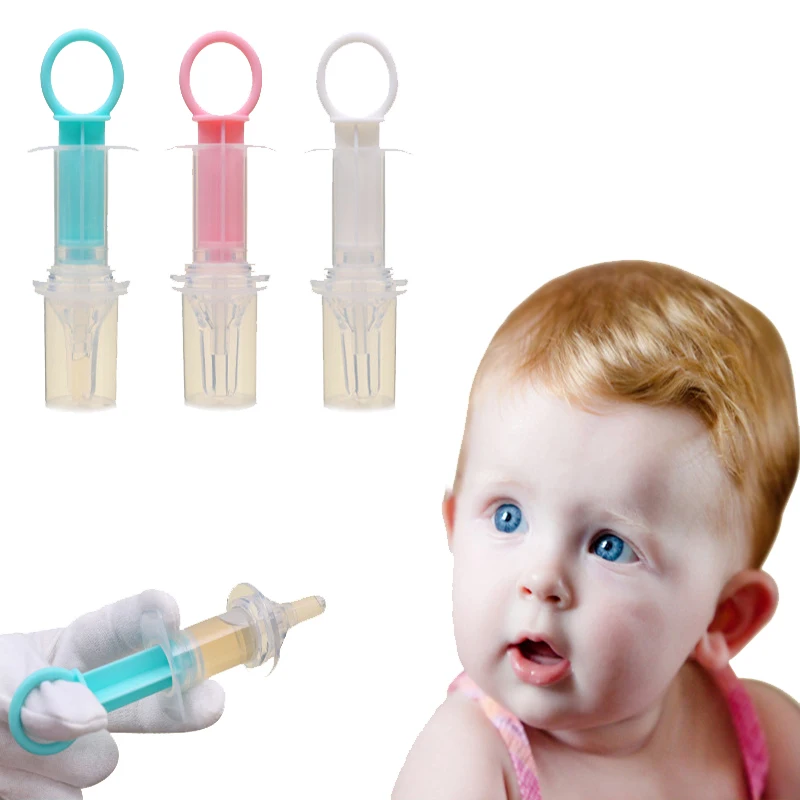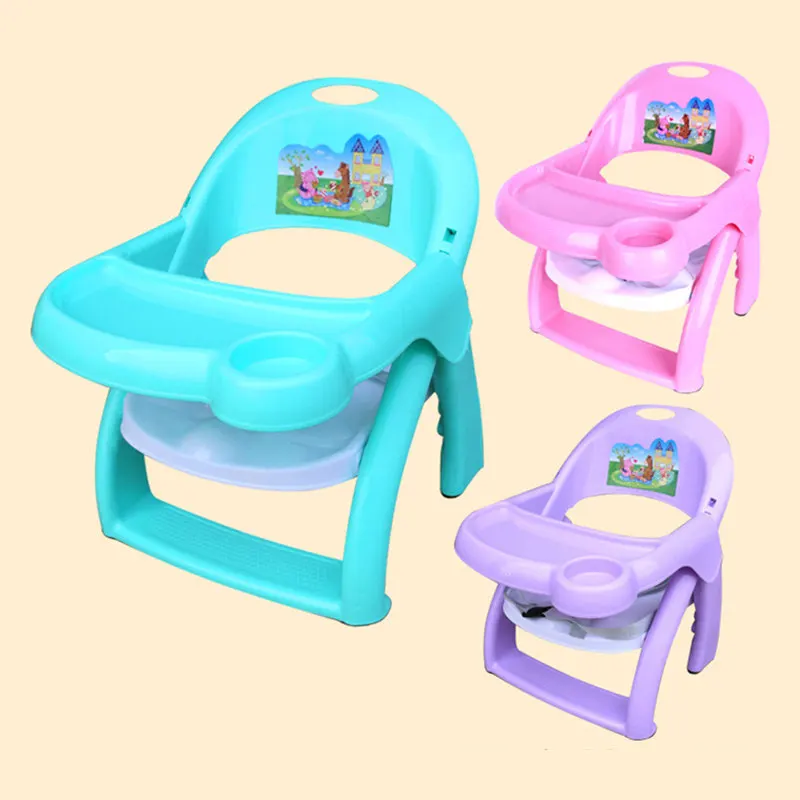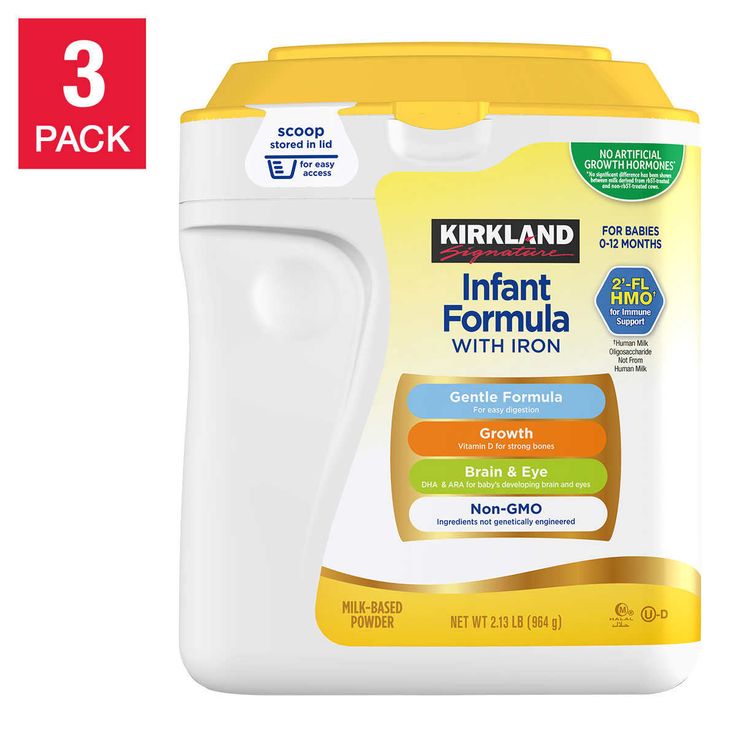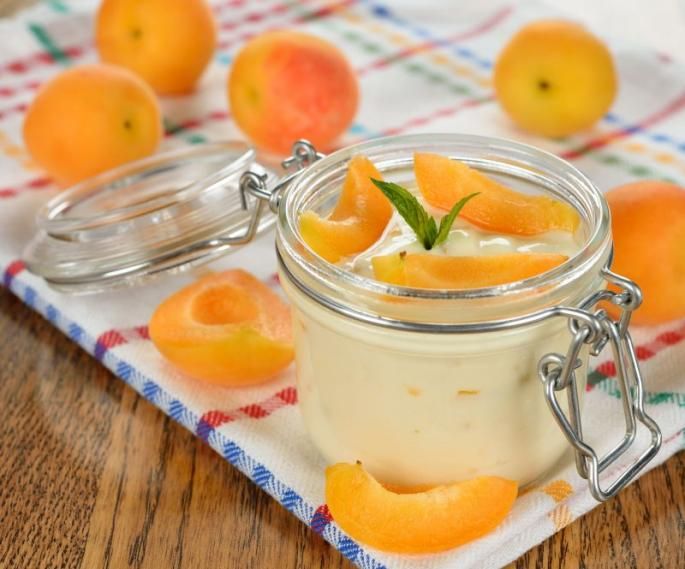4 month old feeding schedule with baby food
4 Month Old Baby Feeding Schedule And Solid Food
·
Written by Jo Charnock
·
Written by Jo Charnock
On this Page:
- Starting Solids At 4 months?
- 4 Month Old Baby Feeding Schedule
- 4 Month Old Baby Feeding Schedule And Solid Food
- Solid Foods For A 4 Month Old
- Final Thoughts
Beginning a 4 month old baby feeding schedule and solid food may seem impossible right now, but it is important to at least try.
At 4 months your baby will be getting all the nutrition they need from breast milk or formula. From 3-4 months your baby should be starting to recognise day and night time. They should be sleeping a bit longer at night, but still waking up 2-3 times for night feeds.
So now is a good time to try and start a 4 month old baby feeding schedule. If you can establish a 4 month old baby feeding schedule, it will help make life easier when you want to start a 5 month old baby routine or even a 6 month old routine for a health, happy baby.
However you may be wondering what is a normal 4 month old baby feeding schedule with solid food? Can you even start solids at 4 months? The answer is yes you can, but it will depend very much on your baby.
Starting Solids At 4 Months?
Experts agree that babies get all the nutrition they need from being exclusively fed breast milk or formula up until they are 6 months old. However, every baby develops differently and some may be showing signs that they are ready for solids earlier than others.
Signs that a baby is ready to start solids include:
- He or she can sit upright unattended, and has good head and neck control.

- They are showing an interest in your food or what is on your plate.
- Your little one is reaching out for your food.
- He or she is voluntarily opening his or her mouth to accept food.
If your baby is showing these signs after 4 months of age you may want to try them with small amounts of purees and solid foods. These foods should never replace a milk feed at this early stage. And you should never start your baby on solids before they reach 4 months.
If your baby is not yet ready to start with solid foods, they will not show interest and will just push the puree back out of their little mouth. This can be frustrating. But remember, don’t force the issue. Ditch the puree and try again in a few days, or even in a weeks time.
4 Month Old Baby Feeding Schedule
At 4 months most mums find a schedule of 5 day feeds and 2-3 day-time naps works well with this age group. Your baby may still wake up 1 or 2 times during the night for night feeds.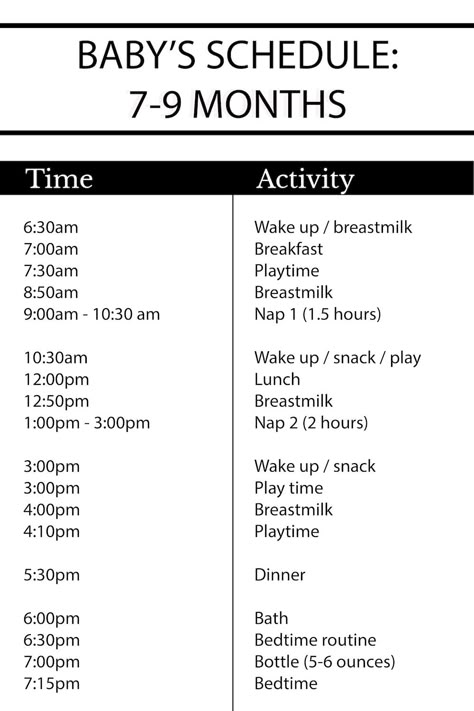
4 Month Old Baby Feeding Schedule and Solid Food
If your baby is showing signs that they are ready to start solid foods, you may want to start a 4 month old solid food feeding schedule.
You can begin by introducing small amounts 2-3 times a day, after your baby has been breast or formula fed. Don’t try and give your baby new foods when they are hungry. When a young baby is hungry they will just want food they are familiar with and will refuse to take something new.
Tips to start your 4 month old baby feeding schedule include:
- Trying to keep to regular feeding times for both milk feeds and when you include solids.
- Start by breast or formula feeding and then introduce a small amount of solid food.
- Introduce solid food safely using a baby food feeder
- Remember to take things slowly and do not push your baby into eating solids.
- Let them eat as much or as little as they want.
- Offer new foods one at a time to make it easier to detect any food allergies your baby may have.

- Do not add sugar or salt which may cause health problems later on.
Solid Foods For A 4 Month Old
While experts agree that your 4 month old will be getting everything they need from breastmilk or formula, if your baby is showing signs that they are ready for solids consider introducing iron rich foods. Healthy babies are born with enough iron reserves to last them the first 4-6 months. After this they will need to be supplemented with iron rich foods.
Good iron rich foods to feed your 4 month old include:
- iron-fortified baby cereals,
- pureed meats and chicken,
- pureed fish,
- cooked tofu,
- cooked legumes (such as lentils, beans and chickpeas)
Other foods to start your 4 month old include:
- smooth pureed cooked vegetables such as squash, sweet potato, carrot and zucchini,
- smooth pureed cooked fruits like apple and pear,
- finely mashed fruit like banana or avocado,
- unsweetened, full-fat yogurt.

A great way to introduce puree's to your 4 month old and control the amount they are eating is to squeeze a small amount of puree onto a shallow spoon and gently let baby taste. Reusable food pouches and spoons are the perfect no mess solution that both serve and store the puree and also store tidily in your fridge using a pouch organiser.
Always remember that solid foods are just a supplement at this stage and your 4 month old will still get their main source of food from your breastmilk or formula. It is recommended to carry on breast or formula feeding until they are at least 12 months.
Final Thoughts
Remember that all babies are different, and so a baby feeding routine that works for one mum and baby may be different from yours. If something is not working don’t be afraid to make adjustments to suit you and your baby. If your baby is healthy, happy and meeting his or her developmental goals then you are doing things just right!
References:
Introducing Solids: why, when, what and how – Raising Children
Introducing solid food – PregnancyBirthBaby
3-6 month baby routines – Tresillian.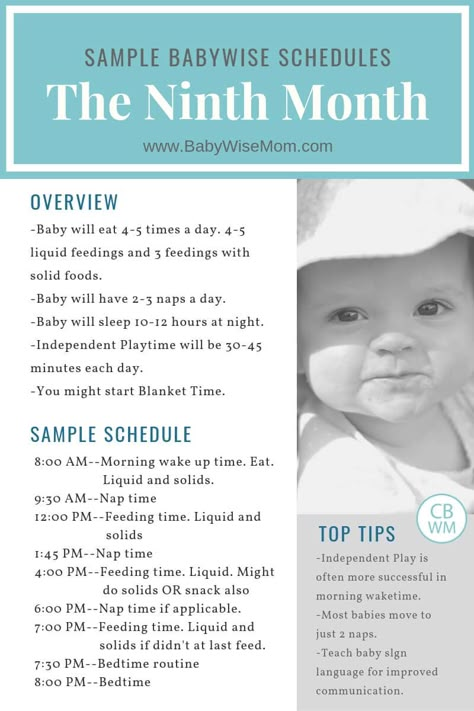 org.au
org.au
Tagged in
- Starting solids
Continue reading
Microplastics And Babies - What You Should Know
How To Warm A Baby Bottle Safely
Top 10 Baby Shower Messages
How to Introduce Solid Foods to your Baby {4-6 months}
The process of starting your baby on solid foods can be daunting to a first {or fourth} time mom! It feels like you finally get into a great sleeping/eating routine and then just like *that* it’s time to add something new to the mix.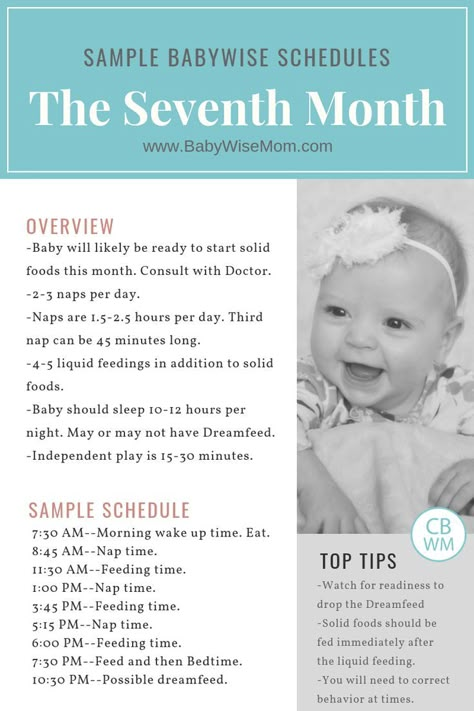 Well, after having four kids I want to share some tips and tricks from my experience on How to Introduce Solid Foods with your baby! Hopefully I can help make the introduction of baby food fun and not the least bit scary!
Well, after having four kids I want to share some tips and tricks from my experience on How to Introduce Solid Foods with your baby! Hopefully I can help make the introduction of baby food fun and not the least bit scary!
So this post discusses how to start out. In later posts I will show you how I prepare different foods for my babies!
Where we are at with nursing when we introduce solid foods.I am all about getting my kids on a schedule. If you aren't, it's ok....one of the beautiful things about motherhood is the variety in it's methods. However, I swear by the book Babywise and all of my girls have slept through the night by 2 months old, which is invaluable to me.
Since I build a routine into our family, my babies pretty quickly adapt to the 3-hour nursing schedule and stick with it for the first 5-6 months of their cute little lives. This schedule determines when/how often I feed solids, so here is what a typical day looks like for us from birth to about 6 months old.
Every pediatrician my kids have seen has recommended starting solids by 6 months of age, with permission to begin as early as 4 months. I usually fall somewhere in between those two. I make the choice to start based on our life circumstances {e.g. we aren't super busy}. This time I started because ALL of my kids AND my husband were dying to see Mara eat food and feed her! LOL! Peer pressure at it’s finest.
There are a few signs to look for to determine if your baby is ready to give solid foods a go!
She is interested in food.I notice my babies getting interested in the food I’m eating around 4-5 months old. They watch as I put a spoon in my mouth or lean in towards my plate to catch a closer look at the food on it. Mara actually went to grab my bowl of quinoa salad and spilled it allllll over the floor! She clearly is wondering what's going on during mealtime!
She can hold up her head.You cannot feed a baby while she's laying down. 😉 Once our little ones can sit in a bumbo for at least 10 minutes without getting too tired then I know they are strong enough to sit up for a feeding!
😉 Once our little ones can sit in a bumbo for at least 10 minutes without getting too tired then I know they are strong enough to sit up for a feeding!
When you put a toy in your baby’s hands does she immediately put it in her mouth? Then they are likely ready to eat from a spoon.
Your baby will likely spit out most of the food you feed her at first. The first week or so is just getting her used to eating from a spoon. It’s not about calories or the amount of food that they actually ingest, as much as it is about teaching her a new skill that is completely foreign to her!
Remember, your baby can live on breastmilk alone for the first 6-7 months of her life, so relax and have fun. If she doesn't get the hang of it after a week you might want to stop and try again later.
Now, since I've waited until I was pretty sure my babies were more than ready to eat solid foods, they have all been champs. I made Mara's food a little thicker than I usually have in the past to start, and she did great! You will know what your baby can handle as you try different things!
I made Mara's food a little thicker than I usually have in the past to start, and she did great! You will know what your baby can handle as you try different things!
The bulk of your baby’s nutrition needs to come from breastmilk {or formula}. It is important that your baby nurses or drinks her bottle first so she does not fill up on solid foods before she receives the nutrition she needs. Any solid foods should be considered supplements to nursing at the 4-8 month stage.
Start with very thin/liquidy “food”My husband laughs and says we start our babies on "liquid foods" not solids. Eating is a new skill for your baby. She is only used to ingesting liquids, so if you try to feed her thick, pasty food she will likely gag, choke and not be able to swallow it. If you begin with cereal make it very thin and runny. If you begin with avocado or sweet potato blend it with enough water to make it easy to swallow for your child.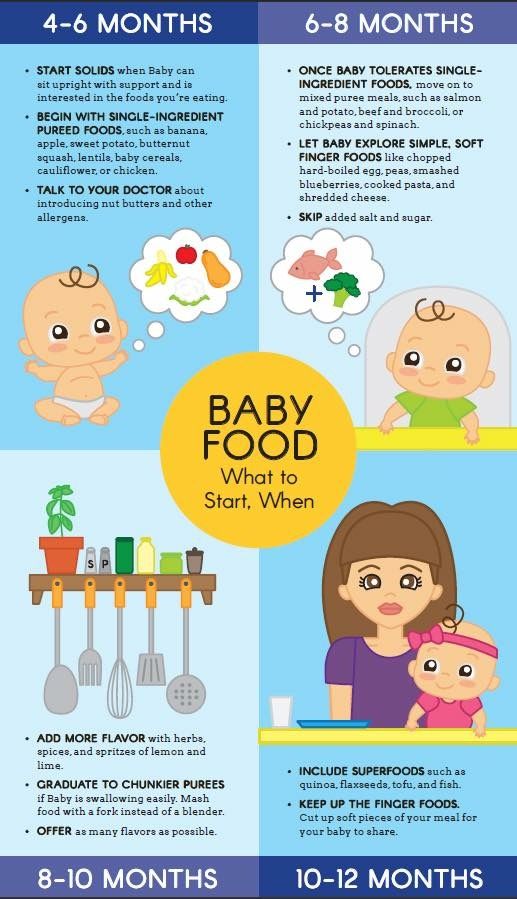
When it’s time to start solid foods I usually choose to introduce new foods at the lunchtime feeding (11 AM). I do this because it is the longest stretch of time my babies are awake during the day, so I can observe them and see if they have an allergic reaction to new foods.
It’s very important to be certain that your child is not allergic to the foods you feed them. Do not feed your baby a new food and put them down for a nap right away. You run the risk of being unaware if they have an allergic reaction, which I don't have to tell you, is not good.
Introduce solid foods 1 at a time with 4-5 days in between.This also is to ensure that you are certain your child is not allergic to the foods they are eating. If you introduce multiple foods at a time and your child has a reaction, you will be unable to discern which food is causing the problem. If you have only fed them one new food and they react poorly to it, then you know exactly what the cause is!
Ok, so here is a super practical chart of how I introduce solid foods week by week. The first week is just getting your baby used to eating from a spoon and increasing food intake. After that I try to add a new feeding every week for the first three weeks until they are eating breakfast, lunch and dinner {again, always nursing first}.
The first week is just getting your baby used to eating from a spoon and increasing food intake. After that I try to add a new feeding every week for the first three weeks until they are eating breakfast, lunch and dinner {again, always nursing first}.
Remember your baby’s stomach is the size of their cute little fist. Do not jam them full! Every baby is different. At the beginning stages of eating solids all my babies ate about 2-4 TBS of food per meal. However, you need to listen to your baby and watch their cues. If they start pulling their head away, pushing the spoon away with their hands, refusing to open their mouths, etc. then they are telling you they are done. Please don’t force your baby to finish all the food you prepare for them. They are learning and so are you. I have often mixed up a meal for my baby only to have them eat 2 TBS of it. I simply put the rest in the refrigerator for the next meal!
New FoodsOnce you have worked up to 3 meals/day, the goal is to continue introducing new foods, one every 4-5 days! Here is a list of foods that are great for a beginning eater {4-6 months}
After you have introduced your baby to many different foods and are feeding her three times a day, you will be able to get into a routine that works for your family.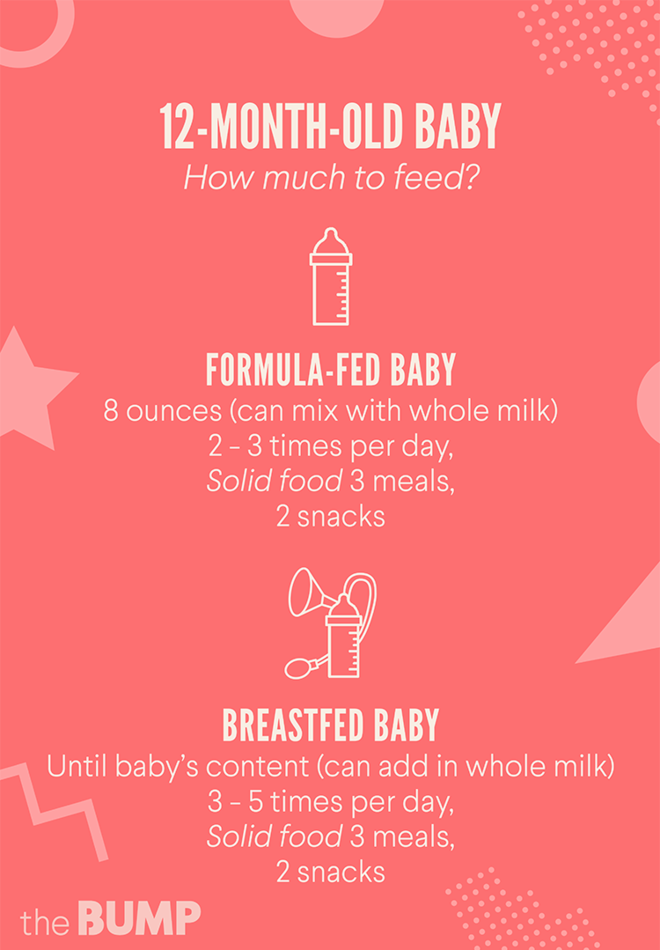
Since times for meals vary so widely from family to family, I've created a graphic with a typical day for my babies around 6-8 months! I try to vary the type of fruits and veggies I feed them daily. If they eat an orange vegetable at lunch, I serve a green veggie at dinner. If they have bananas at breakfast, they get pears at the next meal!
If at first you don't succeed, try try again. I had to introduce avocado to my oldest 4 times before she actually liked it and ate it willingly. My mom thought I was being mean feeding her a food she didn't like {LOL}. But I truly believe that we {parents} determine whether or not our children become picky eaters.
Of course it's easier to only feed your baby the foods she absolutely loves and gobbles up willingly. However, we try to parent for the later, not just the now. So even though now I'd just like to fill her belly with bananas so she takes a good nap, it's very important to me that my children learn to eat what they are served, whether they love it or not.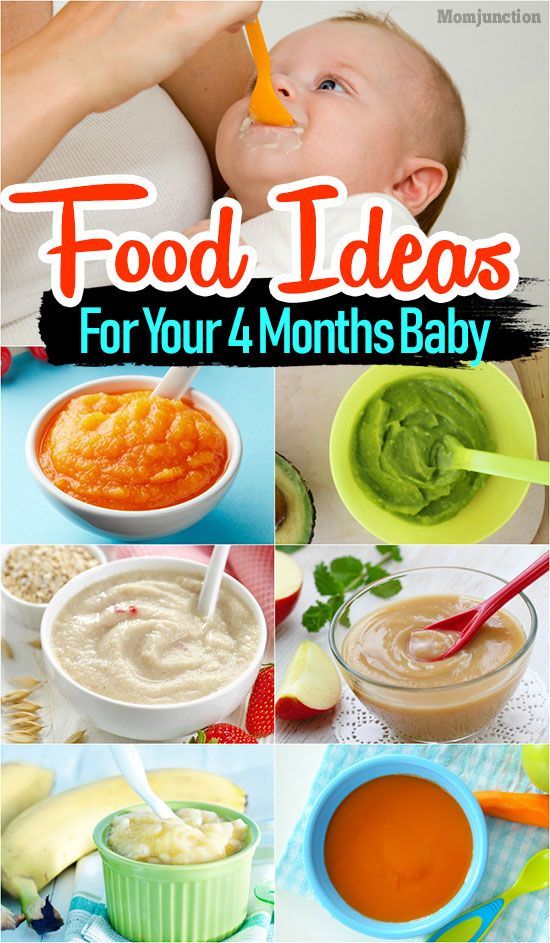
And finally, here is a list of products that I use {and love} to make baby food. The list is short and simple but all of these things are staples in my baby-feed life!
VitamixSurprise surprise right?! I actually bought my first Vitamix when my oldest daughter was starting solids so that I could make baby food for her, {and smoothies for me}! 😉 It has become my most beloved kitchen tool {as you know if you've spent any amount of time on my blog}!
Silicone molds/ice cube trays make it SO easy to freeze baby food in perfectly, pre-portioned amounts. I use silicone ice cube molds or mini brownie trays to freeze the baby food in 1 or 2 TBS portions. Then I simply reheat it in the microwave for 30 seconds per cube!
These bibs were life changing. We didn't discover them until my second child {Gabe} was like 2 years old. I love that you can wipe them clean after eating instead of needing to throw them in the washer every time! LOVE.
I'm pretty sure we got the spoons we use regularly from the dollar store! LOL! Just make sure you get little ones that your baby can easily put in their moth!
You will have to feed your baby on the go. You will need a way to transport your homemade baby food! Here are a few great options!
That's it! You don't need anything crazy fancy to make your baby food! Simple, easy, cost effective and nutritious!
Do you have any questions about introducing your baby to solid foods that I didn't answer in this post?!If you make something from JoyFoodSunshine I would love to see your creations! Don't forget to rate this recipe and leave a comment below! Also, follow along with me on Instagram, Pinterest, Facebook and Twitter for more recipe inspiration and a glimpse into our everyday life!
This post contains affiliate links, which means that if you purchase a product through a link you clicked on here, I receive a portion of the sale.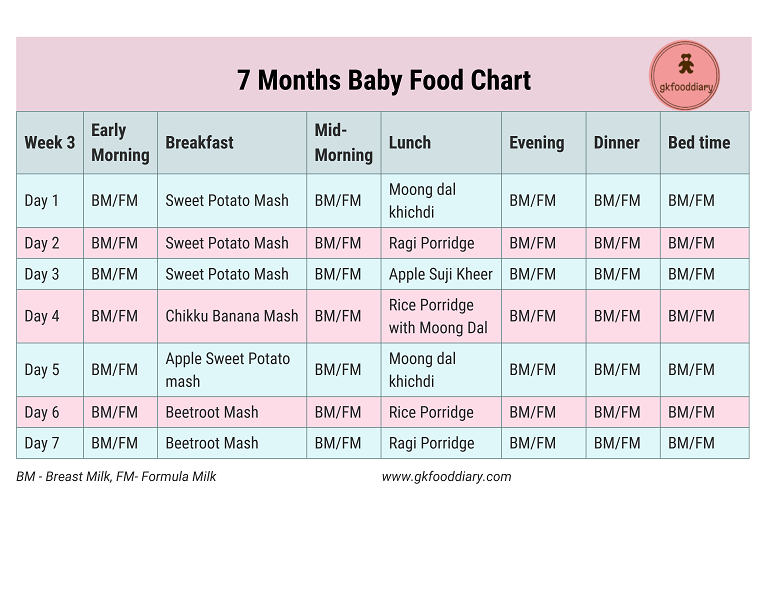 Thank you for supporting JoyFoodSunshine!
Thank you for supporting JoyFoodSunshine!
Diet for a 4-6 month old baby
Your baby is already 4 months old. He has noticeably grown up, become more active, is interested in objects that fall into his field of vision, carefully examines and reaches for them. The emotional reactions of the child have become much richer: he joyfully smiles at all the people whom he often sees more and more often, makes various sounds.
You are still breastfeeding your baby or have had to switch to mixed or formula feeding. The child is actively growing, and only with breast milk or infant formula, he can no longer always get all the necessary nutrients. And that means it's time to think about complementary foods.
The optimal time to start its introduction is between 4 and 6 months, regardless of whether the baby is receiving breast milk or formula. This is the time when children respond best to new foods. Up to 4 months, the child is not yet ready to perceive and digest any other food.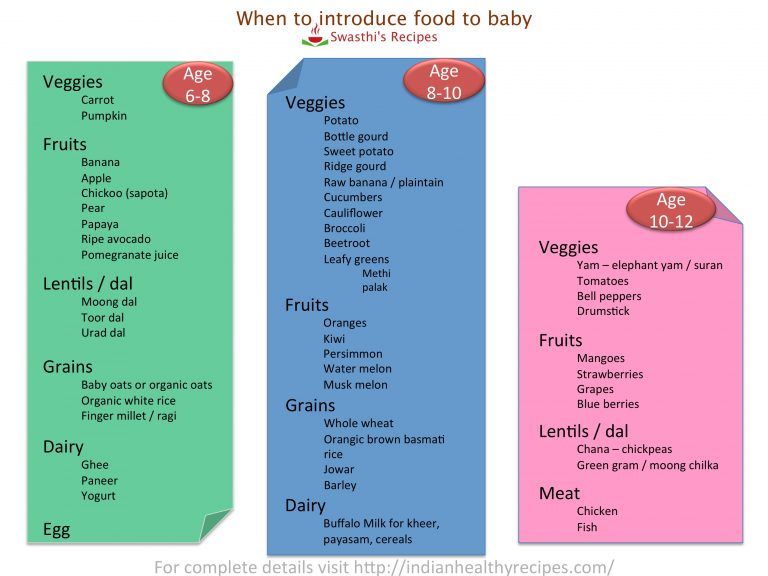 And with the late introduction of complementary foods - after 6 months, children already have significant deficiencies of individual nutrients and, first of all, micronutrients (minerals, vitamins, long-chain polyunsaturated fatty acids, etc.). In addition, toddlers at this age often refuse new foods, they have delayed development of chewing skills for thick foods, and inadequate eating habits are formed. It is important to know that, no matter how strange it may seem at first glance, with a delayed appointment of complementary foods, allergic reactions more often occur on them.
And with the late introduction of complementary foods - after 6 months, children already have significant deficiencies of individual nutrients and, first of all, micronutrients (minerals, vitamins, long-chain polyunsaturated fatty acids, etc.). In addition, toddlers at this age often refuse new foods, they have delayed development of chewing skills for thick foods, and inadequate eating habits are formed. It is important to know that, no matter how strange it may seem at first glance, with a delayed appointment of complementary foods, allergic reactions more often occur on them.
When is it advisable to introduce complementary foods as early as 4 months, and when can you wait until 5.5 or even 6 months? To resolve this issue, be sure to consult a pediatrician.
As a rule, at an earlier age (4 - 4.5 months), complementary foods are introduced to children at risk of developing iron deficiency anemia, as well as children with insufficient weight gain and with functional digestive disorders.
The optimal time to start complementary foods for a healthy baby is between 5 and 5.5 months of age.
The World Health Organization recommends that breastfed babies should be introduced to complementary foods from 6 months of age. From the point of view of domestic pediatricians, which is based on extensive practical experience and scientific research, this is possible only in cases where the child was born on time, without malnutrition (since in these cases the mineral reserves are very small), he is healthy, grows well and develops. In addition, the mother should also be healthy, eat well and use either specialized enriched foods for pregnant and lactating women, or vitamin and mineral complexes in courses. Such restrictions are associated with the depletion of iron stores even in an absolutely healthy child by 5-5.5 months of age and a significant increase in the risk of anemia in the absence of complementary foods rich or fortified with iron. There are other deficits as well.
The first complementary food can be vegetable puree or porridge, fruit puree is better to give the baby later - after tasty sweet fruits, children usually eat vegetable puree and cereals worse, often refuse them altogether.
Where is the best place to start? In cases where the child has a tendency to constipation or he puts on weight too quickly, preference should be given to vegetables. With a high probability of developing anemia, unstable stools and small weight gains - from baby cereals enriched with micronutrients. And if you started introducing complementary foods with cereals, then the second product will be vegetables and vice versa.
If the first complementary food is introduced at 6 months, it must be baby porridge enriched with iron and other minerals and vitamins, the intake of which with breast milk is no longer enough.
Another important complementary food product is mashed meat. It contains iron, which is easily absorbed. And adding meat to vegetables improves the absorption of iron from them.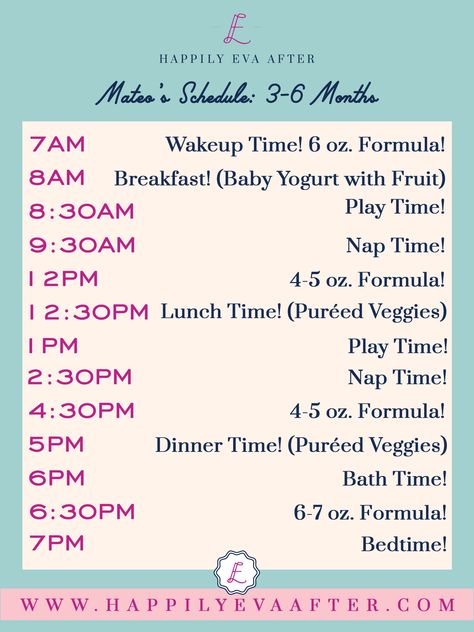 It is advisable to introduce meat puree to a child at the age of 6 months. Only the daily use of children's enriched porridge and meat puree can satisfy the needs of babies in iron, zinc and other micronutrients.
It is advisable to introduce meat puree to a child at the age of 6 months. Only the daily use of children's enriched porridge and meat puree can satisfy the needs of babies in iron, zinc and other micronutrients.
But it is better to introduce juices later, when the child already receives the main complementary foods - vegetables, cereals, meat and fruits. After all, complementary foods are needed so that the baby receives all the substances necessary for growth and development, and there are very few in their juices, including vitamins and minerals.
Juices should not be given between feedings, but after the child has eaten porridge or vegetables with meat puree, as well as for an afternoon snack. The habit of drinking juice between meals leads to frequent snacking in the future, a love of sweets is instilled, children have more tooth decay and an increased risk of obesity.
With the start of the introduction of complementary foods, the child is gradually transferred to a 5-time feeding regimen.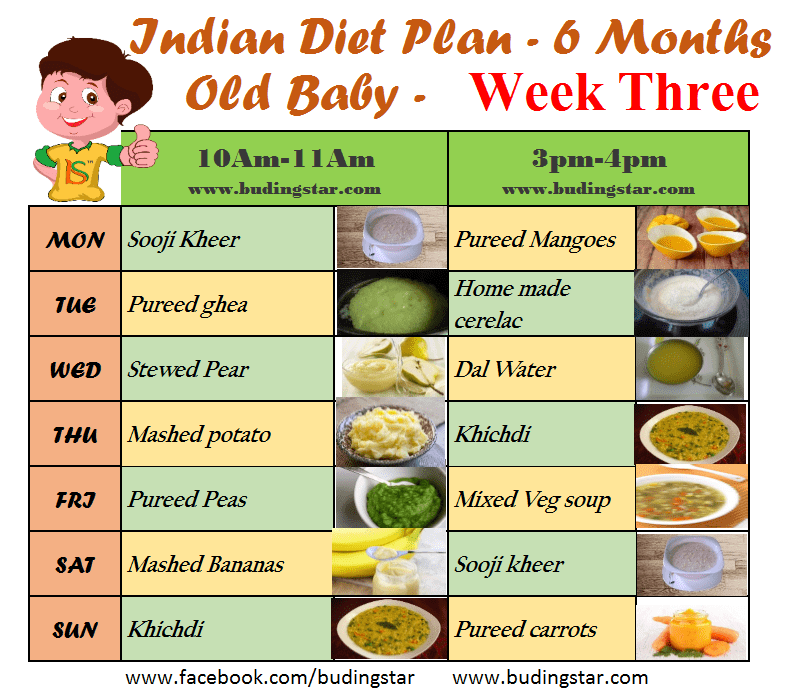
Rules for the introduction of complementary foods:
- preference should be given to baby products of industrial production, they are made from environmentally friendly raw materials, have a guaranteed composition and degree of grinding
- Complementary foods should be offered to the baby by spoon at the start of feeding, before breastfeeding (formula feeding)
- the volume of the product increases gradually, starting with ½ - 1 spoon, and in 7 - 10 days we bring it to the age norm, subsequent products within the same group (cereals from other cereals or new vegetables)
- can be entered faster, in 5 - 7 days
- start introduction with monocomponent products
- it is undesirable to give a new product in the afternoon, it is important to follow how the child reacts to it
- do not introduce new products in the event of acute illnesses, as well as before and immediately after prophylactic vaccination (should be abstained for several days)
When introducing a new type of complementary food, first try one product, gradually increasing its amount, and then gradually “dilute” this product with a new one.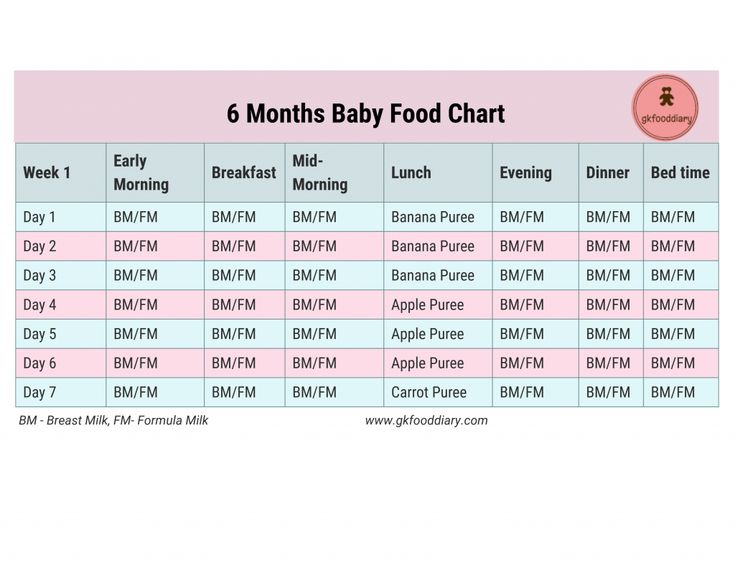 For example, vegetable complementary foods can be started with a teaspoon of zucchini puree. During the week, give the baby only this product, gradually increasing its volume. After a week, add a teaspoon of mashed broccoli or cauliflower to the zucchini puree and continue to increase the total volume every day. Vegetable puree from three types of vegetables will be optimal. The portion should correspond to the age norm. Over time, you can replace the introduced vegetables with others faster.
For example, vegetable complementary foods can be started with a teaspoon of zucchini puree. During the week, give the baby only this product, gradually increasing its volume. After a week, add a teaspoon of mashed broccoli or cauliflower to the zucchini puree and continue to increase the total volume every day. Vegetable puree from three types of vegetables will be optimal. The portion should correspond to the age norm. Over time, you can replace the introduced vegetables with others faster.
After the introduction of one vegetable (bringing its volume to the required amount), you can proceed to the intake of porridge, and diversify the vegetable diet later.
If the child did not like the dish, for example, broccoli, do not give up and continue to offer this vegetable in a small amount - 1-2 spoons daily, you can not even once, but 2-3 times before meals, and after 7 - 10, and sometimes 15 days, the baby will get used to the new taste. This diversifies the diet, will help to form the right taste habits in the baby.
Spoon-feeding should be done with patience and care. Forced feeding is unacceptable!
In the diet of healthy children, porridge is usually introduced after vegetables (with the exception of healthy breastfed children, when complementary foods are introduced from 6 months). It is better to start with dairy-free gluten-free cereals - buckwheat, corn, rice. At the same time, it is important to use porridge for baby food of industrial production, which contains a complex of vitamins and minerals. In addition, it is already ready for use, you just need to dilute it with breast milk or the mixture that the baby receives.
Children suffering from food allergies are introduced complementary foods at 5-5.5 months. The rules for the introduction of products are the same as for healthy children, in all cases it is introduced slowly and begins with hypoallergenic products. Be sure to take into account individual tolerance. The difference is only in the correction of the diet, taking into account the identified allergens. From meat products, preference should first be given to mashed turkey and rabbit.
From meat products, preference should first be given to mashed turkey and rabbit.
Diets for different age periods
Explain how you can make a diet, it is better to use a few examples that will help you navigate in compiling a menu specifically for your child.
From 5 months, the volume of one feeding is on average 200 ml.
Option 1.
If your baby started receiving complementary foods from 4-5 months, then at 6 months his diet should look like this:
| I feeding 6 hours | Breast milk or VHI* | 200 ml |
| II feeding 10 hours | Dairy-free porridge** Supplementation with breast milk or VHI* | 150 g 50 ml |
| III feeding 14 hours | Vegetable puree Meat puree Vegetable oil Supplemental breast milk or VHI* | 150 g 5 - 30 g 1 tsp 30 ml |
| IV feeding 18 hours | Fruit puree Breast milk or VHI* | 60 g 140 ml |
| V feeding 22 hours | Breast milk or VHI* | 200 ml |
* - infant formula
** - diluted with breast milk or VHI
Option 2.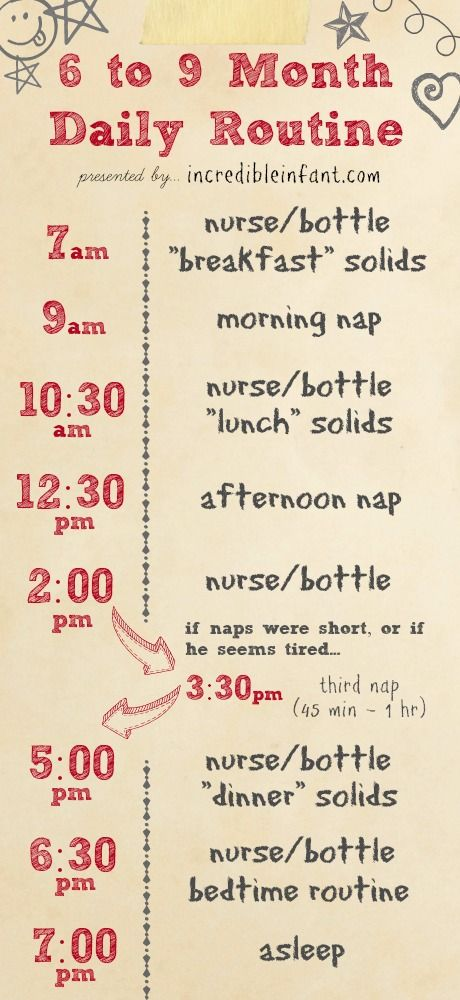
* - infant formula Option 3. : ** - diluted with breast milk Up to 7 months, increase the volume of porridge and vegetable puree to 150 g and introduce fruit puree. The materials were prepared by the staff of the Healthy and Sick Child Nutrition Laboratory of the National Research Center for Children's Health of the Ministry of Health of Russia and are based on the recommendations given in the National Program for Optimizing the Feeding of Children in the First Year of Life in the Russian Federation, approved at the XV Congress of Pediatricians of Russia (02.2009d.) It is well known that the ideal time to introduce complementary foods is between 4 and 6 months of age. The presence of a child's teeth or the ability to sit are not signs of a child's readiness for complementary foods. It is important that the baby does not have a reflex of pushing the spoon with his tongue, and he can swallow food thicker than breast milk or formula well. The pediatrician will help determine the exact start date for complementary foods, and in most cases this is the golden mean of 5-5. The first product of complementary foods, regardless of the age and type of feeding of the baby (breast or artificial), should be energy-intensive foods: either porridge or vegetable puree. Mashed vegetables can be the first meal of the day if a child is prone to constipation, when it is better to choose zucchini, which can have a mild laxative effect on the child's stool. Starting from the 4-5th day of the introduction of vegetable puree, vegetable oil can be gradually added to it (up to 5 g per serving of vegetables in 150 g). Of the first cereals, it is better to give preference to buckwheat or rice. They must be dairy-free and can be diluted with water or breast milk, or the mixture that the baby eats. Later, you can introduce corn and oatmeal. The first vegetable puree can be zucchini, broccoli, or cauliflower. The third type of complementary food can be fruit puree from apples or pears. Later, you can introduce mashed banana or apricot. At first, fruit puree can not be given to the child separately, but it is better to mix it with cereal or vegetables so that the child does not begin to prefer the sweet taste of fruits. When the amount of fruit puree reaches 50 g or more, it can also be given separately, for example, after the child has eaten porridge or for an afternoon snack. Juices should not be the first feeding, in addition, they can not be introduced into the baby's first year of life at all, given their sweet taste and low nutritional value. You can prepare the first complementary foods yourself, but it is safer to use hypoallergenic monocomponent cereals or commercially produced purees prepared to high quality standards for baby food. In addition, it is important to consider that industrially produced baby cereals are often fortified with vitamins and minerals, which makes them especially useful for the first feeding. Complementary foods are introduced before breastfeeding or formula. The introduction of a new product should be gradual. But how is it? Please note that if complementary foods are introduced from 4 months, then the introduction of 1 new product may take longer than the introduction of complementary foods from 5 or 6 months, namely up to 10 days or more, depending on the reaction of the baby. Important! If on the 8-10th day of the introduction of a new product, the baby still cannot eat 100-150 ml of porridge or puree at once, then this amount can be divided into 2 or even 3 doses, for example, give 50 ml of porridge in the morning, 50 ml in the afternoon and 50 ml in the evening. I feeding
6 hours Breast milk or VHI* 200 ml II feeding
10 hours Dairy-free porridge**
Fruit puree 150 g
20 g III feeding
14 hours Vegetable puree
Meat puree Vegetable oil
Fruit juice 150 g
5 - 30 g
1 tsp
60 ml IV feeding
18 hours Fruit puree
Breast milk or VHI* 40 g
140 ml V feeding
22 hours Breast milk or VHI* 200 ml
** - diluted with breast milk or VMS 
I feeding
6 hours Breast milk II feeding
10 hours Dairy-free porridge**
Breast milk supplement 100 g III feeding
14 hours Vegetable puree
Meat puree Vegetable oil
Breast milk supplement 100 g
5 - 30 g
1 tsp IV feeding
18 hours Breast milk V feeding
22 hours Breast milk 
Complementary foods at 4 months | Useful tips from the Tyoma brand
 5 months. But there are situations when complementary foods need to be started from 4 months, including even a child who is exclusively breastfed.
5 months. But there are situations when complementary foods need to be started from 4 months, including even a child who is exclusively breastfed. In what cases are complementary foods introduced from 4 months?
How to start complementary foods at 4 months?
 Porridge can be chosen first if the child has loose or unstable stools, and also if the child is underweight. After 4-5 days from the beginning of the introduction of porridge, butter can be gradually added to it (up to 5 g per serving of porridge in 150 g)
Porridge can be chosen first if the child has loose or unstable stools, and also if the child is underweight. After 4-5 days from the beginning of the introduction of porridge, butter can be gradually added to it (up to 5 g per serving of porridge in 150 g) What foods can be introduced into the diet of a child at 4 months?
Kashi
Vegetables

Fruit
Juices
Can you make your own first meal?

How to start the introduction of a new product?







